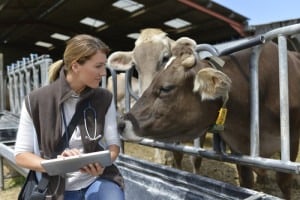
IIoT applications in smart factories have been seeing great returns on investment. Could the farm be the next step in greater connected efficiencies?
Smart manufacturing has reached a tipping point for realizing the promise and potential of Industry 4.0 where machine builders and manufacturers are actively engaged in implementing smart manufacturing systems. Manufacturers across all industries—automotive, oil and gas, consumer goods, electronics, etc. — have invested heavily in IoT to increase efficiencies and they’re recognizing the benefits.
Manufacturers who implemented IoT solutions in 2014 saw an average 28.5% increase in revenues between 2013 and 2014, according to a TATA Consultancy Survey.
See also: How AI can aid the agricultural sector
The IoT represents an inflection point where declines in technology cost and increases in connectivity have made it possible for capabilities, formerly only accessible by the largest of operations, to now be in the reach of smaller operations. This can span from SMBs in a variety of use cases to small, rural farms. For Farmers, the Fourth Industrial Revolution has the potential to raise global income levels and improve the quality of life for populations around the world.
How are Manufacturers Benefitting from IoT? The American Society for Quality (ASQ) surveyed manufacturing companies that have digitized their processes and found astounding results:
- 82% increased efficiency
- 49% experienced fewer product defects
- 45% increased customer satisfaction
What can farming learn from manufacturing?
Due to developments in farming technology and fertilization, production is up but so are costs. Therefore, income from farming is declining. Farmers need to be more efficient, achieve higher yield rates and focused on cultivating a higher quality product – for that leads to higher prices. Just as manufacturers did, farmers will need to uncover new ways of increasing efficiencies through cost-effective IoT solutions.
For example, asparagus is graded for size, color, and tolerances. Asparagus’ “open head measurement” is the special external measurement that gives retailers an idea of the freshness of the product. A top quality spear is ‘tight’, once the small triangular bracts start to open, quality is dropping rapidly. Poor temperature management within an asparagus dam causes considerable quality loss or in manufacturing terms… a defect.
See also: Case study — from farm to cloud in real-time
Excess temperature leads to hollow and ridged asparagus which causes the spearheads to open too early. Such asparagus is downgraded and cost adjusted, making it harder to sell. These losses can be up to 30% of the yield. In manufacturing, a 30% loss rate might put a company out of business. In a colder environment asparagus grows slowly. The temperature in the mound is controlled using a two-colored cover. If the black side of the cover is turned towards the sun the mound is heating up, with the white side up the mound is cooling down. But, it is necessary to know the set point temperature to control it correctly.
For this purpose, a single measurement a day isn’t sufficient. Instead, it is essential to know the average temperature, aggregated by measurements taken throughout the day. There is a high positive correlation between temperature control of the asparagus mound and a high yield share of grade I asparagus. Asparagus is harvested once a year, therefore maximum yield is crucial for maximum return.
Just as IoT helps a factory monitor certain processes to decrease defects, IoT helps asparagus farmers monitor environmental conditions that help increase “Grade A” yields. With a worldwide annual asparagus production of 13.6B pounds, temperature control of the mound is over a $2B opportunity alone. Imagine the potential in your own production environment.
Seven tips from the factories
Now comes the best part. There is a lot to be learned from manufacturers, and because manufacturers have seen such success in production efficiency, I’ve put together some tips and tricks below that farmers, or really any industry participant, can learn from.
#1: People as key players — Virtual assistants and intelligent workplace design help provide workers with production-related information and improved ergonomics, which in turn increases the level of work productivity.
#2: Distributed Intelligence — Decentralized distributed intelligence, an approach used to solve complex learning, planning, and decision-making problems, is integrated with the right software and can perform their tasks independently. This allows machines to make educated, autonomous decisions – allowing more tasks in the workplace to be identified and solved without the time or effort needed from a real person for interaction.
#3: Fast Integration and Flexible Configuration — People, machines, processes and the flow of goods are networked together on an ad hoc basis. Software tools simplify multiple smart manufacturing machine steps: commissioning, integration and (re)configuration, as well as preventive maintenance of all parts of the product and/or machine. Fast communication leads to quicker decision making in the workplace.
#4: Open Standards — Open Standards, standards used to facilitate interoperability and data exchange among different products or services, that extend across manufacturers and are platform-independent form seamless and more streamlined exchanges of information within the networks.
#5: Virtual Real-Time Representation — All components and objects are represented as virtual real-time representations across the entire manufacturing process. These virtual elements are closely linked to their physical counterparts and provide in-context information and insights for continuous process improvement in real-time.
#6: Digital Life-Cycle Management — The comprehensive networking of all automation components, machines, processes and product data — from development and production to recycling — decreases development time and therefore development costs, and this, in turn, creates completely new smart manufacturing lines and upgrades. In addition, the efficiency of the digital life-cycle also ensures the application-oriented design of all components.
#7: Secure Value-Creation Networks; Security and safety for Industry 4.0 includes protecting people from machinery-related hazards (safety) as well as the protection of production facilities and corporate IT from attacks and faults from the surrounding environment (security). This involves securing sensitive data as well as the prevention of intentional and unintentional malfunctions.
In retrospect, IoT and digital transformation will continue to pave the way for workplace efficiency. It will not only continue to be a critical changing point for all businesses – regardless of their industry – but also a mandatory implementation for businesses to continue their success in today’s ever-evolving environment.




























